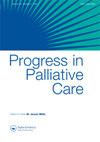Referral patterns and consultation locations for a novel palliative care telehealth service
IF 0.8
Q4 PUBLIC, ENVIRONMENTAL & OCCUPATIONAL HEALTH
引用次数: 0
Abstract
Background The optimal location to conduct telehealth consultations for rural Australian palliative patients was unclear prior to starting a novel palliative telehealth service in Queensland. The present study sought to collect data which may suggest the best location for such consultations so that future service provision can be planned accordingly. Methods A retrospective review of the referral patterns and demographic data between March 2020 and November 2020 was undertaken with a focus on the number of referrals, location of consultations, and the source of referrals. Results 153 referrals resulted in 526 unique consultations. All referrals in the first month came from the local public hospital. After 4 months, public hospital referrals and private family doctor referrals accounted for 30% and 50% respectively. The proportion of telehealth consultations delivered in the patient’s home increased throughout the eight-month period. There was no obvious relationship between referral source and consultation location. Conclusion The patient’s home was the preferred location for all specialist telehealth care and patient preference was the main determinant of consult location. Further research should involve qualitative analysis of these factors to optimize the delivery of this service and the design of other similar services.新型姑息治疗远程医疗服务的转诊模式和咨询地点
背景在昆士兰开始一项新的姑息性远程医疗服务之前,为澳大利亚农村姑息性患者进行远程医疗咨询的最佳地点尚不清楚。本研究试图收集数据,这些数据可能表明进行此类咨询的最佳地点,以便对未来的服务提供进行相应规划。方法对2020年3月至2020年11月期间的转诊模式和人口统计数据进行回顾性审查,重点关注转诊数量、会诊地点和转诊来源。结果153例转诊导致526例独特会诊。第一个月的所有转诊都来自当地的公立医院。4个月后,公立医院转诊和私人家庭医生转诊分别占30%和50%。在八个月的时间里,在患者家中进行远程医疗咨询的比例有所增加。转诊来源和会诊地点之间没有明显的关系。结论患者的家是所有专家远程医疗的首选地点,患者的偏好是咨询地点的主要决定因素。进一步的研究应包括对这些因素的定性分析,以优化这项服务的提供和其他类似服务的设计。
本文章由计算机程序翻译,如有差异,请以英文原文为准。
求助全文
约1分钟内获得全文
求助全文
来源期刊

PROGRESS IN PALLIATIVE CARE
PUBLIC, ENVIRONMENTAL & OCCUPATIONAL HEALTH-
CiteScore
2.60
自引率
11.80%
发文量
24
期刊介绍:
Progress in Palliative Care is a peer reviewed, multidisciplinary journal with an international perspective. It provides a central point of reference for all members of the palliative care community: medical consultants, nurses, hospital support teams, home care teams, hospice directors and administrators, pain centre staff, social workers, chaplains, counsellors, information staff, paramedical staff and self-help groups. The emphasis of the journal is on the rapid exchange of information amongst those working in palliative care. Progress in Palliative Care embraces all aspects of the management of the problems of end-stage disease.
 求助内容:
求助内容: 应助结果提醒方式:
应助结果提醒方式:


